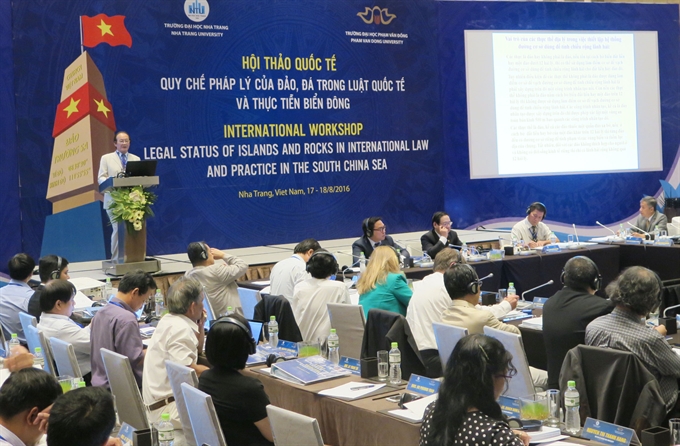 Politics & Law
Politics & Law

The arbitral ruling last month laid out a historic legal basis for a step closer to resolving territorial disputes in the East Sea (South China Sea), yet it will take patience to expect any breakthroughs on the way, especially a change of view from China, experts have said.
 |
Nha Trang, KHÁNH HÒA – The arbitral ruling last month laid out a historic legal basis for a step closer to resolving territorial disputes in the East Sea (South China Sea), yet it will take patience to expect any breakthroughs on the way, especially a change of view from China, experts have said.
The Hague’s Arbitral Tribunal on July 12 rendered its long-awaited ruling in favour of the Philippines against China, slamming its so-called nine-dash-line encircling more than 90 per cent of the East Sea. The award also categorised which features in the Trường Sa (Spratly) archipelago were islands or just mere rocks, of which the latter could not generate a maritime zone according to the United Nations Convention on the Law of the Sea (UNCLOS).
“The ruling rejected the ’historic rights’ of China and significantly narrowed the disputed area among the claimant states,” Phan Duy Hảo, senior research fellow at the National University of Singapore’s Centre for International Law told Việt Nam News on the sidelines of a conference on the East Sea held in Nha Trang in the coastal Khánh Hòa Province yesterday.
“The ruling had each country’s rights to the exclusive economic zone (EEZ) and the continental shelf guaranteed under international law and hence, let them have a legal basis to protect their own interests.”
Before the ruling was handed down, claimants in the East Sea including China, Việt Nam, the Philippines, Taiwan, Brunei and Malaysia all had their own territorial claims which overlapped with each other’s, turning one of the busiest sea routes in the world into a regional powder keg, especially with the increasing military manoeuvres of China.
Beijing had maintained its tough rhetoric over the last month, after denouncing the decision as “null and void”. Tensions reached their peak when Chinese Defence Minister Chang Wanquan called on the military and the whole country to prepare for a potential “people’s war at sea”, according to the Xinhua news agency on August 2.
Yet, former head of the Vietnamese Government’s Border Committee, Trần Công Trục, said that Beijing removed mentions of their unilateral nine-dash-line in hawkish statements made after the ruling, and that was a signal Việt Nam should take notice of.
“The legal basis given out by the ruling is not a panacea for the East Sea dispute, yet at least we now have something to move on to resolve it,” he said.
Việt Nam, as well as the international community, could not force or expect China – the Asian powerhouse attempting to save face - to formally recognise the arbitral ruling, Hảo said.
The Hague award is legally binding yet whether it will be observed by relevant parties, particularly China in this case, is another matter, due to a lack of an international enforcement mechanism.
“There is no international police force to make countries implement the ruling,” said Erik Franckx, Member of the Permanent Court of Arbitration, and President of the Department of International and European Law, Vrije Universiteit Brussels, Belgium.
“But even big countries can’t live against international law, especially when they are members of the Security Council which should set examples for other smaller nations.”
“But of course we have to be patient. We can’t expect China to change overnight.”
Marine environment damages
China’s actions and their effect on East Sea marine life, from overfishing, giant clam poaching, and the construction of artificial islands that killed coral reefs en masse were crimes, said the Việt Nam Nature and Marine Environment Association Chairman, Nguyễn Chu Hồi.
The East Sea is one of the top ten biodiversity centres of the world, contributing one tenth to global fishing production, that some 300 million people from nine countries and territories rely on for a living, according to Hồi.
Yet he said that China’s rampant activities in the East Sea, which were called out by the arbitral court ruling as having “violated its obligation to preserve and protect fragile ecosystems and the habitat of depleted, threatened, or endangered species” and “inflicted irreparable harm to the marine environment”, were causing severe damage to the environment.
“Chinese fishermen were sweeping the entire sea, pushing the giant clams, sea turtles and sharks to the edge of extinction,” he said.
A satellite analysis made public by John McManus from the University of Miami in mid July indicated that more than 104sq. kms of coral reef had been destroyed by Chinese giant clam poaching in the East Sea. Another 58 sq kms of reef disappeared after island-building activities, largely by Beijng to solidify its military presence in the region. The coral reef area eliminated by China’s land-reclamation in the East Sea was at least 48 times larger than the initial estimation of about 1.2 sq kms announced by the Philippines’ Department of Foreign Affairs last year.
China’s land reclamation projects – carried out on the sand spits, islets and submerged reefs of the Spratly islands stretching to more than 3,200 acres, according to the Pentagon – have been carried out since 1988 and have grown more intense in recent years.
Việt Nam, for its part, started to feel the heat from China’s activities in the East Sea as recent research recorded a 16 per cent decrease in commercial fish stocks in the western part of the East Sea compared to 2010, Hồi said.
Prof. Ngô Vĩnh Long from Maine University said that countries in the region should reach some consensus in order to stop the marine destruction caused by China’s activities in the long-term.
“What it takes is a unified voice in the region to put pressure on China,” he said. – VNS